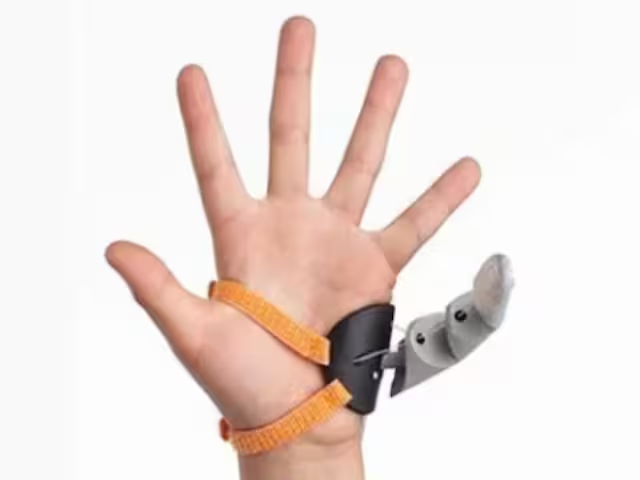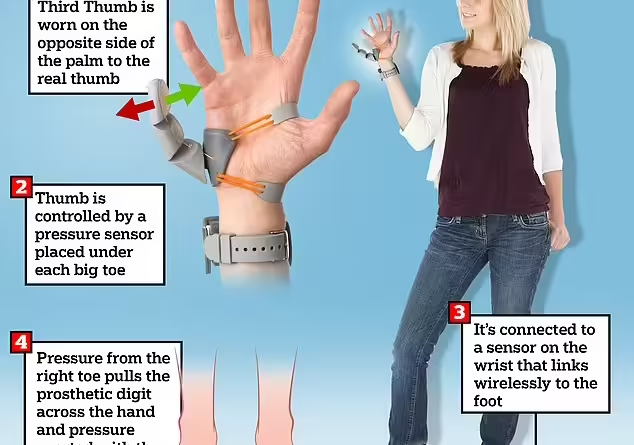Prosthetics: The Third Thumb 24
Prosthetics
The creative project known as “Third Thumb” was created by augmentation-focused designer Dani Clode. With this wearable, one can essentially turn their five-fingered hand into a six-digit instrument by adding a second thumb on the hand’s opposite side from the biological thumb. Naturally occurring foot movements allow for intuitive operation of the third thumb with pressure sensors carefully positioned beneath each big toe.

A typical hand layout would make it difficult or impossible for the wearer to accomplish tasks, but this special control mechanism makes it possible.
By exploring the possibilities of prosthetics—the Third Thumb Augment—to improve daily usefulness, Dani Clode’s design pushes the limits of human capability. The third thumb gives you an additional digit that improves your dexterity and grip strength. This can lead to new opportunities in a variety of industries, from manufacturing and healthcare to arts and crafts.
The wearable device not only demonstrates the usefulness of wearable technology but also the extraordinary adaptability of the human brain to new tools and interfaces. The Third Thumb, an example of motor augmentation, is a major advancement in the fusion of robotics and human physiology and provides a window into a future in which inventive technology and design will enable us to surpass our biological constraints.
A wide range of volunteers tested this novel robotic gadget, highlighting the significance of inclusivity in emerging technological advancements. For such innovations to be widely used and useful, it is imperative that they serve everyone.
In the developing field of future technology, motor augmentation, the “third thumb” marks a major advancement. In order to improve our motor abilities beyond what is currently possible due to biological constraints, motor augmentation refers to the employment of motorized wearables, such as exoskeletons or additional robotic body components.
These gadgets have enormous potential to improve human capacities, provide new opportunities for individuals with impairments, and increase the capabilities of the general population.
Researchers are creating a path toward a time when human-robotic integration will significantly improve daily routines, professional pursuits, and even artistic endeavors by improving our capacity to control prosthetic devices with ease. The extraordinary neuroplasticity of the human brain is highlighted by the participants’ quick adaptation when operating the third thumb, indicating that with experience, the integration of such devices may become natural.
This discovery expands the potential applications of wearable technology and creates interesting new avenues for personal augmentation.
What are prosthetics?
Prosthetics is a branch of medicine and engineering that focuses on creating and fitting prosthetics—artificial limbs or body parts—to replace missing or severed body parts. Prosthetics are used to help people who have lost limbs or other body parts as a result of disease, accident, or congenital problems regain their functioning and live better lives.
Prosthetics’ essential features include:
Design and Fabrication: Each user’s prosthetic device is made specifically to meet their individual needs and physical characteristics. In order to guarantee usefulness, comfort, and longevity, this technique frequently makes use of cutting-edge materials and technologies.
Functionality: Modern prosthetics try to mimic the native limb’s range of motion and capacities as much as possible. This covers both basic mechanical prostheses with hinges and springs and more sophisticated myoelectric prostheses that control movement with electrical inputs from the user’s muscles.
Prostheses come in a variety of forms, which vary based on the bodily part that needs to be replaced. These consist of prosthetic limbs for the upper and lower extremities, such as hands and arms and feet and legs, respectively.
Rehabilitation and Adaptation: Rehab and training are frequently necessary for effective prosthetic use. Prosthetists and physical therapists assist patients in regaining as much function and adjusting to their new limbs as possible.
Technological Developments: As prosthetics continues to advance, new technologies are being included. Examples of these include biomaterials, neuroprosthetics, and robotics. These technologies directly interact with the nervous system to enhance control and sensory feedback.
Follow our Digiknowledge.co.in page for the latest updates about technology, bikes, cars, sports, lifestyle, and many more.
How do prosthetics work?
With prosthetics, people can carry out daily tasks and maintain a good standard of living by having a missing limb or body part replicated in function. The structural elements, control mechanisms, and user interface of prosthetic devices can be roughly classified into three categories of operation. Below is an in-depth analysis.
Parts of the Structure
The prosthetic component that attaches to the residual limb is called a socket. It is developed specifically to fit the user in a secure and comfortable manner.
Suspension System: Maintains the prosthesis’s adherence to the body. Techniques include suction, straps, and locking mechanisms.The frame, which is often composed of lightweight materials like titanium or carbon fiber, offers structural support.
Bones: Artificial joints provide for more mobility and flexibility by mimicking the movement of real joints, such elbows or knees.The prosthetic component that communicates with the outside world is called a terminal device. This might be a foot for lower limb prosthetics and a hand or hook for upper limb prosthetics.
Management Frameworks
Body-Powered Prosthetics: Utilize harnesses and cables that the wearer moves their body to operate. To open or close a hook, for instance, one can move their chest or shoulder to draw a cord.
Externally Powered Prosthetics: The prosthetic is moved by motors and batteries. These are frequently managed by the user’s muscles’ myoelectric impulses.
Myoelectric prosthetics: These prosthetics are controlled by electrical signals produced by the muscles of the residual limb. These signals are detected by skin electrodes, which convert them into movement.
Microprocessor-Controlled Prosthetics: Utilize cutting-edge processing capability to provide flexible responses. For instance, a knee controlled by a microprocessor can change resistance when walking to mimic a more natural gait.
Engaging with the User
Fit and Alignment: For comfort and functionality, it is essential that the prosthesis fits properly. Natural movement is made possible by proper alignment, which also aids in weight distribution.
Training and Rehabilitation: In order to learn how to use their prosthesis properly, users frequently require physical therapy. The main goals of training are to increase control, coordination, and strength.
Sensory Feedback: The goal of advanced prosthetics is to provide users the ability to “feel” through their prosthetics. Neural interfaces and tactile sensors are just two examples of the technologies that can be used to accomplish this.
Cutting-edge technology
Bionic Limbs: Combine cutting-edge robotics and sensors for more natural-feeling mobility and improved control. Individual finger movements and adaptable grip strength are a couple examples of this.
Neuroprosthetics: Provide a direct nerve system interface for more natural control. The prosthetic device can receive impulses from electrodes implanted in the brain or peripheral nerves.
Use smart materials to improve the prosthesis’s functionality by allowing it to alter its shape or stiffness in response to external stimuli.
What is the purpose of the third thumb device?
A novel adjustable additional thumb has been revealed by researchers at Cambridge University to boost efficiency, from carrying several beverages to performing surgery with razor-sharp precision.
Which device is used for thumb impressions?
A biometric device is any device that is used to collect biometric data, such as an individual’s fingerprint, iris, or both, from Aadhaar number holders.
What does the thumb represent in the brain?
Commence with the palm, which governs their fundamental bodily processes. The thumb resides in the lower brain with the palm and is symbolic of strong emotions like stress or rage. The thinking, upstairs brain is represented by the other fingers.




